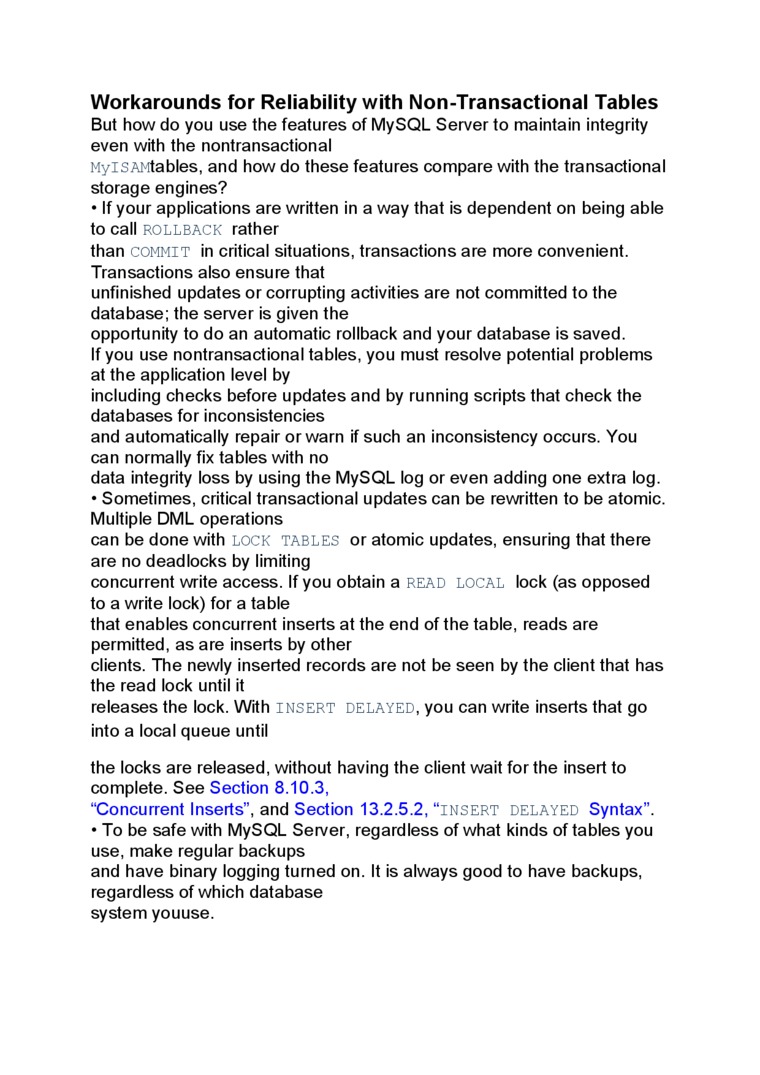79651

Workarounds for Reliability with Non-Transactional Tables
But how do you use the features of MySQL Server to maintain integrity even with the nontransactional
MylSAMtables, and how do these features compare with the transactional storage engines?
• If your applications are written in a way that is dependent on being able to cali rollback rather
than commit in critical situations, transactions are morę convenient. Transactions also ensure that
unfinished updates or corrupting activities are not committed to the database; the server is given the
opportunity to do an automatic rollback and your database is saved.
If you use nontransactional tables, you must resolve potential problems at the application level by
including checks before updates and by running Scripts that check the databases for inconsistencies
and automatically repair or warn if such an inconsistency occurs. You can normally fix tables with no
data integrity loss by using the MySQL log or even adding one extra log.
• Sometimes, critical transactional updates can be rewritten to be atomie. Multiple DML operations
can be done with LOCK TABLES or atomie updates, ensuring that there are no deadlocks by limiting
concurrent write access. If you obtain a read local lock (as opposed to a write lock) for a table
that enables concurrent inserts at the end of the table, reads are permitted, as are inserts by other
clients. The newly inserted records are not be seen by the Client that has the read lock until it
releases the lock. With insert delayed, you can write inserts that go into a local queue until
the loeks are released, without having the Client wait for the insert to complete. See Section 8.10.3,
“Concurrent Inserts”, and Section 13.2.5.2, “insert delayed Syntax”.
• To be safe with MySQL Sen/er, regardless of what kinds of tables you use, make regular backups
and have binary logging turned on. It is always good to have backups, regardless of which database system youuse.
Wyszukiwarka
Podobne podstrony:
InnoDB Notes For InnoDB tables, be careful if you modify the column containing the auto-increment va
89 TransAlp Manual General Specifications Service 3 8 MAINTENANCE Check the O-rings of the valve adj
UNIT4. TIME FOR OUTDOORS. Lesson I. Weathermix. L58 131 But we’re thankful together, Whatever the we
htdctmw 087 Never forget—once you learn the basie rules, it’s fun to change them and come up with yo
Non-radioactive labels in transgene detection 911 Therefore the mRNA of v-Ha-ror were detected using
1.1 Local Area Networks The type of Computer network to be studied in 1.1 is a single isolated LAN w
7 Team work 224 7.1 Who do you work together with? 125 7.2 How d
6 The extensive character of this economy is accounted for by the fact that the ąuality of water sta
40. Środki transportu: He usually drives to work but sometimes he takes the bus. How do you travel t
Writing 1 4B Communicatiye grammar BI You probably know three or four thousand English adjectives,
76094 image065 (7) Gęg _ Update Driver Software - ABBJndustry_0y DDCC+How do you want to search for
Vcrpwr2 NOTĘ: 1. DO NOT USE THE PART NUMBER SHOWN ON THIS DRAWING FOR ORDERING- THE CORRECT PART NUM
MySQL Enterprise Oracle offers technical support in the form of MySQL Enterprise. For organizations
Quick Test Setup of MySQL Cluster To familiarize you with the basics, we will describe the simplest
107 X The United States is prepared to accept and act in accordance with the balances of interests r
więcej podobnych podstron